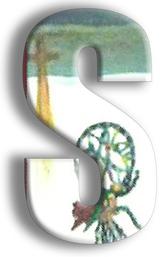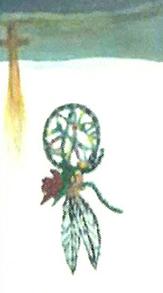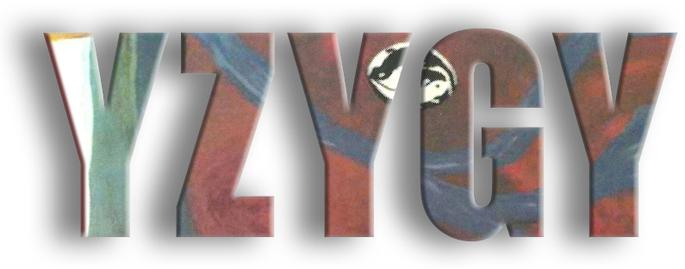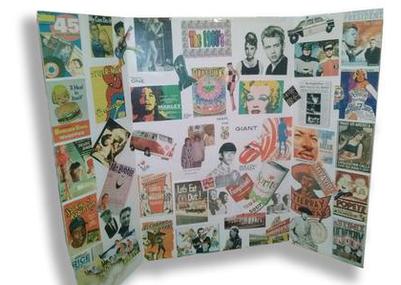MEMOIR LOGO CONCEPT: The aleph and a Sufi mystic inspired my creation and design of the syzygy logo, which I initially based on the symbolism of the yin and yang.
But the concept expanded when I first saw the aleph in Judith Cornell’s
Mandala Healing Kit, My inexplicable attraction to it led me to incorporate it into my logo before I knew what it meant.
I later read that the “Aleph (the first letter of the sacred Hebrew alphabet) embodies the primordial, divine potential of the universe. ... Aleph contains all the universe’s potential and all of its emptiness simultaneously. Aleph represents a dynamic process of movement from unity to diversity and back to unity,” Jennifer Judelsohn, Songs of Creation.
And the mystic poet Rumi inspired me to use the fire and water concept after I read The Question. Here is an excerpt:
“The presence is there in front of me. A fire on the left, a lovely stream on the right.
One group walks toward the fire, into the fire. Another toward the sweet flowing water.
No one knows which are blessed and which are not.
Whoever walks into the fire appears suddenly in the stream.
A head goes under water, and that head pokes out of the fire.”
LOGO ART: Cropped fire and water images from Free Images.
LOTUS LOGO: In spiritual and religious literature, “the lotus is a symbol for the macrocosm and the microcosm, the universe and man. The lotus represents the divinity of the cosmos as well as the divinity of man.
The lotus is the center of the infinite, omnipresent consciousness which connects with the consciousness of the universe. Through the intuition, one of man’s divine gifts, the spiritual student can see the infinite, omnipresent consciousness as the lotus flower within himself.”
LOTUS ART: Courtesy
Homestead, my website service provider. (Temporary art while I design of my own lotus logo.)
TO DOWNLOAD FREE SAMPLE CHAPTER OF SYZYGY:
THE MEMOIR
TO BUY MEMOIR
(Thru Amazon)
THE MEMOIR
CROSSING THE BRIDGE TO SELF
THE WEBSITE
THE MEMOIR
NEW!
S
SENSATION
• They live in the present enjoying what is here and now.
They live in the present enjoying what is here and now.
• They like to deal with what is real and concrete.
They like to deal with what is real and concrete.
• They like what can be observed, heard, and touched.
They like what can be observed, heard, and touched.
• They like sequential thinking, that is, numbers, facts, details, and instructions from start to finish.
They like sequential thinking, that is, numbers, facts, details, and instructions from start to finish.
• They live in the present and are by nature pleasure lovers and consumers.
They live in the present and are by nature pleasure lovers and consumers.
• They are, in general, content.
They are, in general, content.
• They observe at the expense of imagination.
They observe at the expense of imagination.
• They desire to handle practical matters.
They desire to handle practical matters.
• When conversing, they give specific information or answers, and end sentences with a period. That’s it!
When conversing, they give specific information or answers, and end sentences with a period. That’s it!
• They will correct details if they are wrong.
They will correct details if they are wrong.
• They are usually on time.
They are usually on time.
• They like to set procedures and establish outlines. ♂
They like to set procedures and establish outlines. ♂
N
INTUITION
• They live toward future, anticipating what may be.
They live toward future, anticipating what may be.
• They like to deal with intangibles: what can be imagined, created, designed, and invented.
They like to deal with intangibles: what can be imagined, created, designed, and invented.
• They like to follow hunches and inspiration, looking for meaning and patterns.
They like to follow hunches and inspiration, looking for meaning and patterns.
• They may jump in anywhere, leaping over steps.
They may jump in anywhere, leaping over steps.
• They live for the future and are by nature initiators and promoters. They are generally restless.
They live for the future and are by nature initiators and promoters. They are generally restless.
• They are imaginative at the expense of observation.
They are imaginative at the expense of observation.
• They desire opportunities and possibilities.
They desire opportunities and possibilities.
• When conversing, they give general information or answers and end sentences with “…… ” (open ended). More to come!
When conversing, they give general information or answers and end sentences with “…… ” (open ended). More to come!
• They could care less about details.
They could care less about details.
• They like change and variety. Is often a poor judge of passing of time.
They like change and variety. Is often a poor judge of passing of time.
• They may be late. ♂
They may be late. ♂
thumbing through them all, she picked up the stack and quietly sorted them: keepers from the trash.
Intuit (me): I might have thought something like this: “How ungrateful! She finds fault with everything he does. Plus, she took the creativity right out of it by arranging them on the poster board already. The next thing you know, she’s going to tell me exactly how to place each of them.”
Sensor (my sister-in-law): She may have thought something like this: “Is she blind or what! How can she not see that some of these are totally unusable? Let’s be realistic here. It looks like too many to fit the poster board anyway so I will weed out the less desirable ones and see if there are enough decent images to fill the board.
Analysis: After studying the basic differences between an N (intuit) and an S (a sensor), I realize that while I was looking at the big picture, figuratively and literally, my sister-in-law was looking at the details. She saw that some of the images were blurry or cut off in a strange way, and she evaluated each, prioritizing the most relevant to the least relevant, and she took a mental count to see if there were too many or not enough, and then placed them on the poster board so that she could see the big picture.
I on the other hand, as an intuit, saw the big picture first. But as I began to build the collage that I had conceptualized in my mind, as I sorted the pictures according to theme and color and shape, cutting silhouettes of some and cutting some with borders and cutting irrelevant details out of others, I began to see the details, the blurry pictures, the duplicated images, the weird angles.
Only then could I see what my sister-in-law saw. I then realized that she was not being critical at all. She was simply calling it as she saw it from her unique vantage point.
Self-Evaluation Inherent Flaw
I must admit, I had initially fooled myself into believing I was also an introvert. But as I read various descriptions of the characteristics of extroverts in my recent research, I began to question the outcome of my test back in 1999, in which I tested 7/3, in favor of an introvert.
So I went back to that test and took a really hard look at my answers as objectively insofar as I am capable and realized that I evaluated myself on the characteristics I desired rather than those I actually possessed. I retook the test, trying to be as honest as I could with myself, and tested this time 9/1 in favor of the extrovert. I became painfully aware that the extrovert characteristics that I loathe in others were actually my own, which I had so deeply repressed in my shadow, that I was completely unaware of them.
Yes, it sucks. But the good news is now that I am conscious of my overly extroverted behavior, now that I am aware of this huge imbalance between my introverted and extroverted inclinations, I have begun the difficult task of retraining myself, to rein in my spontaneous, boisterous, over-the-top reactions, and to make a conscious effort to tone it down, to listen before I leap, and to pause and think before I respond. I do not always catch myself in time, which embarrasses me, but at least I am now aware of it and can work on it, whereas before I was embarrassing myself and didn’t even know it.
The foregoing provides just a few examples of how, by understanding the differences in the way that various psychological types process their realities—mayonnaise or salad dressing is not the point but rather the balance between the two—that such awareness can hopefully help you to improve your relationships with others—and with yourself, if you are willing to acknowledge and cultivate your least developed perspective—which, by the way, may ultimately enable you to experience “reality” through the eyes of another.
♂ ♀
NOTE: Take the free electronic test. Keep in mind there is no right or wrong answer.
In the process of developing and creating the above ’60s poster, I became painfully aware of the differences between the way that my sister-in-law (an introvert) and I (an extrovert) process information and events.
Do you often see the big picture at the expense of the details or focus on the details and miss the big picture? Neither answer is right or wrong—anymore than it is right or wrong to prefer mayonnaise over salad dressing or vice versa. You don’t know why. You just do. Similarly, the method your brain uses to process and synthesize information and events and the approach your brain prefers to take when seeking solutions to problems is simply a matter of inclination.
This example of the big picture versus the details is a matter of how you perceive information from your environment, primarily through sensation or intuition, according to the Myers-Briggs Type Indicator, or MBTI. One who perceives through intuition tends to see the big picture; one who perceives through sensation tends to see the details. As an intuit, I tend to see the big picture.
When something happens, it’s not like I choose to see one way or another. Rather, my brain is on autopilot; it would take conscious effort for me to see any other way. It takes even greater effort to become aware of which method your brain prefers. For example, one minor detail, “detail oriented” has been a staple phrase on my resume ever since I can remember, and I thought it was true until I just wrote the previous paragraph.
It Is What It Is—Or Is It?
I first took the MBTI test in 1999 and read about my type and the types of those closest to me at the time, and I said, that’s interesting, how closely the descriptions matched my perception of others—as well as their perceptions of themselves. I compared the mating temperaments of the NF (me) to the SP (my husband at the time) [2], and it hurt. It reminded me how I felt when I was committing myself to a lifelong relationship with him, and all he had to say was, “Well, it depends. So long as I don’t get bored.” Disappointed, I put the book back on the shelf. What could I do? It is what it is! That’s what he always said. We went our separate ways the next year.
More than a decade later, when I finally read Jung’s “Approaching the Unconscious,” my eyes popped when I read the section titled “The problem of types,” in which Jung said that he found personality classifications “particularly helpful when I am called upon to explain parents to children and husbands to wives, and vice versa. They are also useful in understanding one’s own prejudices” [3].
I did not recall that Jung had anything to do with personality types or the Myers-Briggs test, which is the only name I knew it by, much less that it was from Jung’s book Psychological Types that Myers-Briggs extrapolated their 16 personality types and later devised a test that would attempt to evaluate a person’s type, which I quickly learned when I launched my Internet Explorer.
Fired up, I began Googling various terms and eventually found myself at an interesting website called Trans4Mind, which expounded on Jung’s viewpoint: “Typology helps us to recognize our innate strengths, weaknesses, and other characteristics ... However, we do not have to view our type as a fatalistic limitation” [4].
Jung loosely defined introverts and extroverts as personality types that determine how a person experiences life, whether inwardly or outwardly and to what degree. He refined these two types to differentiate what he called the four functions of the mind: thinking, feeling, sensation and intuition, and that in each person, one or more of these functions predominate. Jung said that to become whole, all four functions should contribute equally.
At last, all of this was making great sense to me. After all, what was the point of writing a whole book about categorizing types if they were not useful and if they could not be altered? I was finally convinced that understanding different personality types can actually help improve your relationships and—what surprised me most—is that your psychological type is not engraved on your forehead.
And, of course: No wonder just learning about the types wasn’t enough to “activate” any real change in the relationship between Griffin and I. It would require recognition of these principles and efforts to apply them. And then later, as I witnessed a conflict between an introverted sensor and an extroverted intuitive, it became perfectly clear why my sister-in-law and I clashed almost immediately when she invited me into her world.
A Case In Point
The following scenario actually occurred and demonstrates how different people—based on their dominant psychological types—interpret events differently.
Setting the Stage: My brother walked into the kitchen, where my sister-in-law and I were sitting at the table chatting, and showed us a stack of colorful 60s pictures that he had printed from the Internet that I was to use to build a 60s poster for an upcoming party.
Extravert (me, although I tested as an introvert in 2000): As my brother thumbed through each of the images, I gushed stuff like, “Ooh! Ah! That is so cool. That’s awesome!” I could see right away that the poster was going to look really cool and diversified and fun when it was finished.
Introvert (my sister-in-law): As my brother thumbed through each of the images, she didn’t say a word. When he finished
E
EXTROVERT
• They gain energy from people
They gain energy from people
• They think and process by talking with others
They think and process by talking with others
• They are good talkers
They are good talkers
• They talk loud, fast, and tend to interrupt
They talk loud, fast, and tend to interrupt
• They like noisy active environment (radio, TV).
They like noisy active environment (radio, TV).
• They need a lot of verbal feedback and affirmation from others.
They need a lot of verbal feedback and affirmation from others.
• They have conversations with others.
They have conversations with others.
• They tend to be after thinkers. They cannot understand life until they have lived it. They act and then (maybe) reflect.
They tend to be after thinkers. They cannot understand life until they have lived it. They act and then (maybe) reflect.
• Their attitude is relaxed and confident.
Their attitude is relaxed and confident.
• Their focus is more on the outer world of people and things. They need relationships.
Their focus is more on the outer world of people and things. They need relationships.
• They are friendly, talkative, and easy to know. They are more at home with people and things than with ideas.
They are friendly, talkative, and easy to know. They are more at home with people and things than with ideas.
• They unload their emotions as they go along.
They unload their emotions as they go along.
• They tend to be noticed by others. ♂
They tend to be noticed by others. ♂
“According to Jung, the Ego—the ‘I’ or self-conscious faculty—has four inseparable functions, four fundamental ways of perceiving and interpreting reality: Thinking, Feeling, Sensation, and Intuition. Generally, we tend to favor our most developed function, which becomes dominant, while we can broaden our personality by developing the others.”
Gregory Mitchell, Trans4Mind
Whether extrovert or introvert, neither is set in stone
I
INTROVERT
• They are drained by people. They gain energy by solitude and quiet and time to reflect
They are drained by people. They gain energy by solitude and quiet and time to reflect
• They like to think and process inwardly before giving an answer.
They like to think and process inwardly before giving an answer.
• They are good listeners.
They are good listeners.
• They tend to talk slower and like to state thoughts without being interrupted.
They tend to talk slower and like to state thoughts without being interrupted.
• They like a quiet environment, and have a higher power of concentration.
They like a quiet environment, and have a higher power of concentration.
• They need less verbal feedback and affirmation from others.
They need less verbal feedback and affirmation from others.
• They have conversations within their own minds.
They have conversations within their own minds.
• They cannot live life until they understand it. They reflect then (maybe) act.
They cannot live life until they understand it. They reflect then (maybe) act.
• Their attitude is reserved and questioning. They are often reserved, quiet and hard to know.
Their attitude is reserved and questioning. They are often reserved, quiet and hard to know.
• Their focus is on the inner world of ideas. They need privacy.
Their focus is on the inner world of ideas. They need privacy.
• They bottle up their emotions and guard them.
They bottle up their emotions and guard them.
• They don’t like public show. ♂
They don’t like public show. ♂
SOURCES
[1] Carl Jung, Man and His Symbols, pp. 59–60.
[2] Keirsey and Bates, Please Understand Me, p. 92.
[3] Carl Jung, Man and His Symbols, pp. 58–66.
[4] Gregory Mitchell, Trans4Mind.
Extrovert versus Introvert and Sensation versus Intuition
In my travels, I found a website called How We Love that seemed to me to categorize temperament traits in a more compelling and succinct manner than I had found elsewhere, so I would like to share it with you here. I cannot speak for my “favorite” sister-in-law, but if she were to read and compare her qualities of an introverted sensor to my qualities of an extroverted intuitive (which she is unlikely to do given her characteristics of a sensor seems to predispose her lack of belief in such things)—but if she did—I think she would agree that the descriptions of each, for the most part, portray us fairly accurately. (Of course, this is just the tip of who we are. Check back often because I am just getting started on psychological types.)
© 1955–2019 Syzygy: Crossing the Bridge to Self. All Rights Reserved.
According to Jung, “If one is an extrovert and the other an introvert their different and contradictory standpoints may clash right away, particularly when they are unaware of their own type of personality, or when they are convinced that their own is the only right type” [1].











